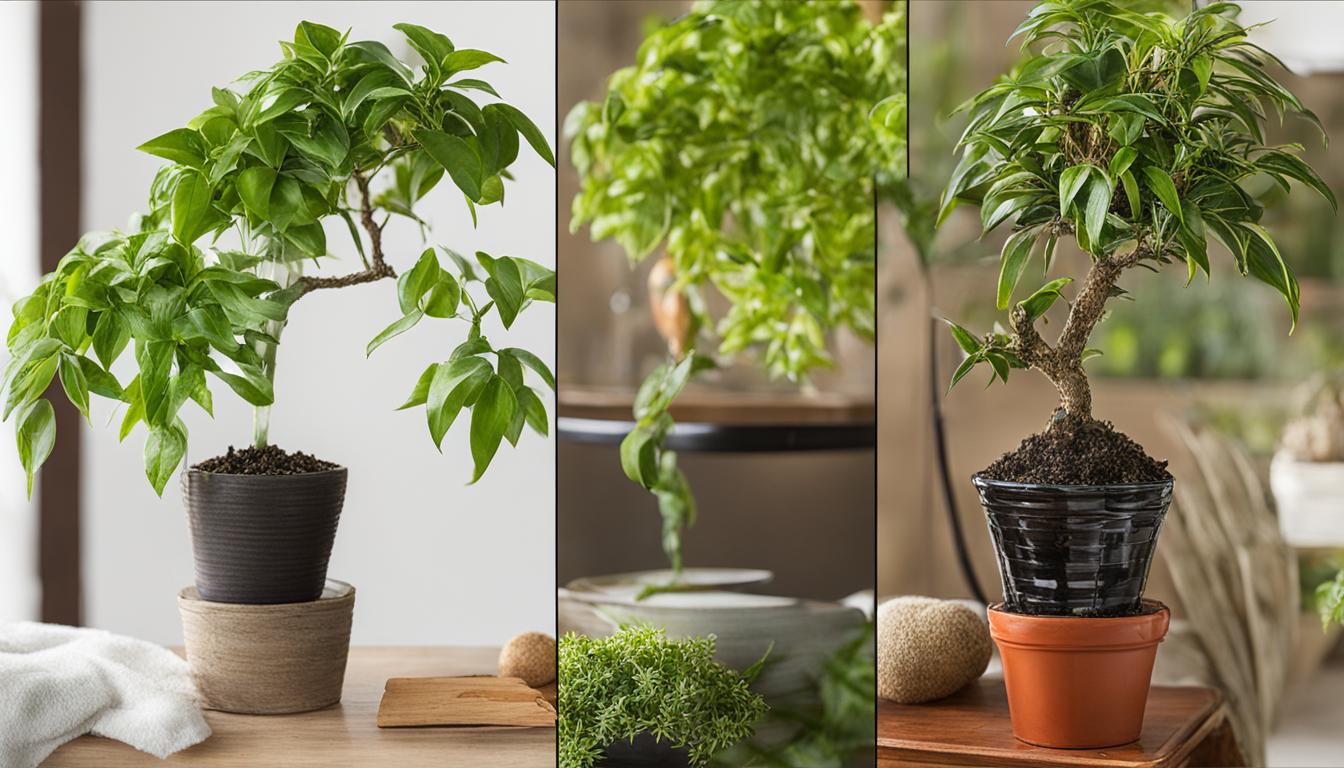
Today, I want to delve into the important techniques of pruning and trimming and shed some light on the differences between them. Many people mistakenly believe that pruning and trimming are the same, but there are distinct variances that every indoor plant enthusiast should know.
So, let’s dive in and explore how these two techniques can contribute to the health and beauty of your indoor plants!
Key Takeaways:
- Understanding the difference between pruning and trimming is crucial for proper indoor plant care.
- Trimming involves removing excess branches and maintaining the shape and size of a plant.
- Pruning focuses on removing dead, diseased, or damaged branches to improve the overall health and appearance of the plant.
- Both pruning and trimming are necessary for maintaining the aesthetics and health of indoor plants.
- By incorporating regular pruning and trimming into your care routine, you can ensure the longevity and beauty of your plants.
The Purpose of Pruning and Trimming
Pruning and trimming serve distinct purposes in indoor plant care, contributing to both the aesthetics and health of the plants. Pruning is primarily aimed at removing dead, diseased, or damaged branches, which not only improves the overall appearance but also enhances the plant’s health and vitality.
By eliminating these potentially harmful branches, pruning promotes better air circulation and sunlight penetration, reducing the risk of diseases and improving the plant’s ability to photosynthesize.
On the other hand, trimming focuses on maintaining the shape and size of the plant for purely aesthetic reasons. By selectively removing excess branches and foliage, trimming helps to control the plant’s growth and prevent it from becoming unruly or overcrowded.
This technique also ensures that the plant remains visually appealing and well-proportioned, making it an essential aspect of indoor plant grooming.
Both pruning and trimming are crucial for the overall care of indoor plants. While pruning contributes to the plant’s health and structural integrity, trimming enhances its visual appeal.
By combining these techniques, plant enthusiasts can achieve a balance between aesthetics and well-being, ensuring that their indoor plants thrive in both appearance and vitality.
| Benefits of Pruning | Benefits of Trimming |
|---|---|
|
|
Tree Trimming Techniques
When it comes to maintaining the size and shape of indoor plants, tree trimming techniques play a crucial role. By carefully removing excess branches and shaping the plant, you can ensure healthy growth and an aesthetically pleasing appearance. Let’s explore some common tree trimming techniques:
1. Crown Reduction
Crown reduction is a technique used to reduce the overall density of a tree. By selectively removing branches, the tree’s size and density can be controlled, allowing more light to penetrate and reach the lower branches. This technique is particularly useful for trees that are becoming overgrown or obstructing views.
2. Canopy Lifting
Canopy lifting involves removing the lower branches of a tree to create clearings and increase vertical clearance. By doing so, you can improve visibility, enhance air circulation, and create space beneath the tree for other plants or activities. Canopy lifting is commonly done in urban areas where trees need to be shaped for aesthetic and practical purposes.
3. Improving Foliage Appearance
Tree trimming can also be done to improve the appearance of a tree’s foliage. This technique involves selectively pruning certain branches to enhance symmetry, balance, and overall visual appeal. Improving foliage appearance can make a significant difference in the overall aesthetics of indoor plants.
By employing these tree trimming techniques, you can maintain the size and shape of indoor plants effectively. It is important to note that proper pruning equipment and techniques should be utilized to ensure clean and precise cuts. Regular tree trimming promotes healthy growth and prevents structural failure, resulting in vibrant and well-maintained indoor plants.
Tree Pruning Techniques
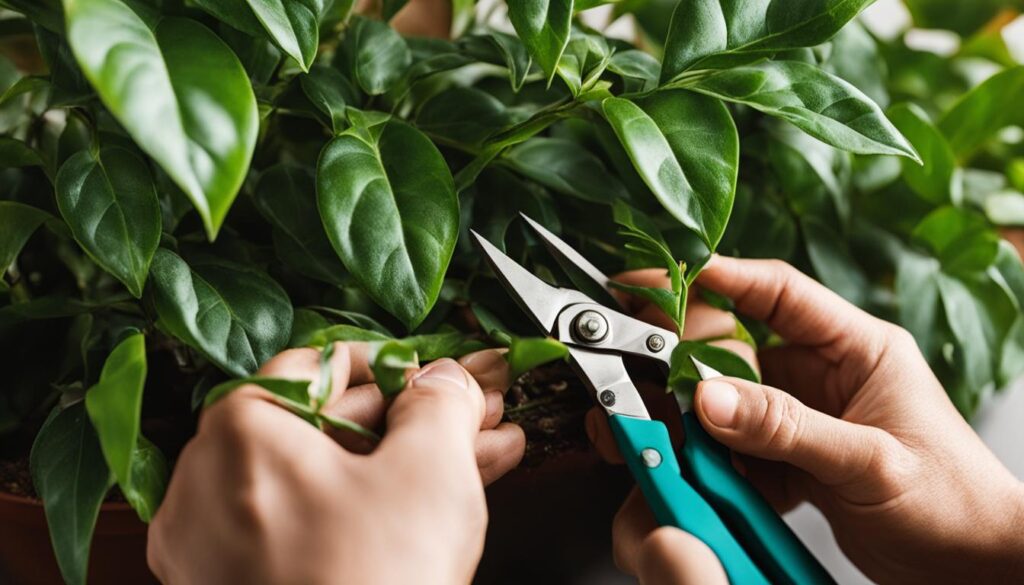
Pruning plays a crucial role in maintaining the health and appearance of indoor plants. It involves the selective removal of dead, diseased, or damaged branches, as well as shaping and thinning out the plant. By employing various tree pruning techniques, you can ensure the optimal growth and overall well-being of your indoor plants.
Key Pruning Techniques
There are several fundamental tree pruning techniques that can be utilized to enhance the health and aesthetics of indoor plants:
- Crown cleaning: This technique involves the removal of broken, diseased, or dead branches from the tree’s canopy. Crown cleaning helps improve air circulation, minimizes the risk of disease spread, and enhances the overall appearance of the plant.
- Crown reduction: By selectively removing branches from the outer portion of the canopy, crown reduction reduces the overall size of the tree. This technique can help maintain the desired height and shape of indoor plants while also promoting healthy growth.
- Thinning: Thinning out the branches involves selectively removing certain branches to increase light penetration and air circulation within the tree. This technique is particularly beneficial for dense indoor plants, as it promotes the growth of new branches and foliage.
When employing tree pruning techniques, it is essential to use sharp, clean pruning tools to ensure clean cuts and minimize the risk of damage or infection. Regular pruning, carried out with precision and proper timing, will contribute to the long-term health and vitality of your indoor plants.
| Pruning Technique | Description |
|---|---|
| Crown Cleaning | Removal of broken, diseased, or dead branches from the tree’s canopy to improve air circulation and overall appearance. |
| Crown Reduction | Selective removal of branches from the outer portion of the canopy to reduce the overall size of the tree, maintaining desired height and shape. |
| Thinning | Selective removal of certain branches to increase light penetration and air circulation, promoting the growth of new branches and foliage. |
Tools for Trimming
In order to effectively trim indoor plants, it is important to have the right tools at your disposal. Here are some essential trimming tools:
- Branch shears (or loppers): These are used for cutting thicker branches and stems. They provide extra leverage and make it easier to remove larger branches.
- Hedge shears: Designed specifically for shaping and maintaining the size of plants, hedge shears are perfect for cutting and shaping hedges, shrubs, and other plants with soft stems.
- Pole pruners: When it comes to reaching higher branches, pole pruners are a must-have tool. They have extendable handles that allow you to reach branches that would otherwise be difficult to access.
These tools are essential for maintaining the shape and size of indoor plants. They ensure clean and precise cuts, promoting healthy growth and overall plant aesthetics.
| Tool | Function |
|---|---|
| Branch shears (or loppers) | Used for cutting thicker branches and stems with extra leverage |
| Hedge shears | Designed for shaping and maintaining the size of plants with soft stems |
| Pole pruners | Allow reaching higher branches with extendable handles |
Tools for Pruning
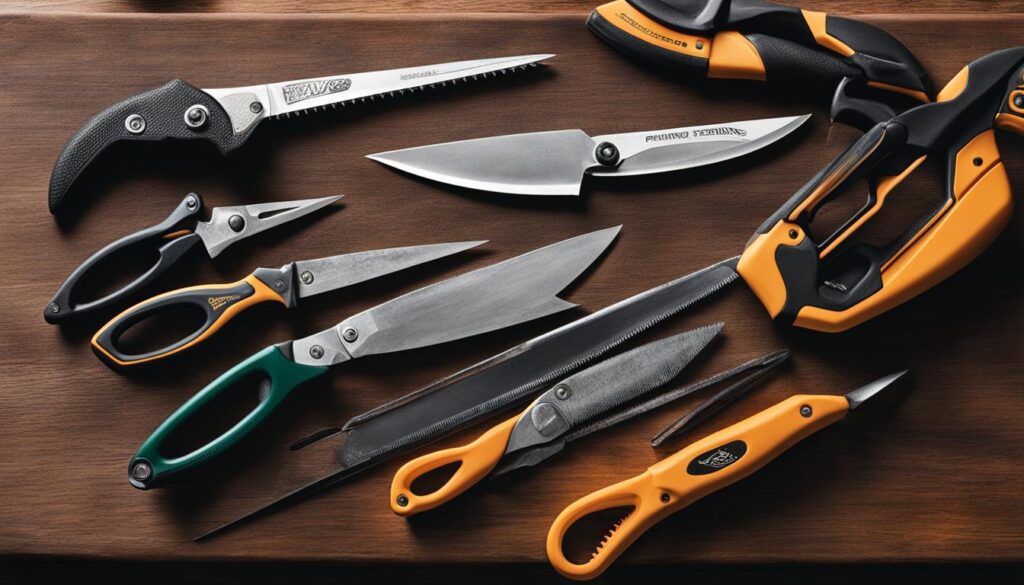
To properly prune indoor plants, it is crucial to have the right tools on hand. The use of appropriate pruning tools ensures clean and precise cuts, promoting the health and appearance of the plants. Here are some essential tools for pruning:
- Handheld clippers: Handheld clippers, also known as pruning shears or secateurs, are small and lightweight tools designed for trimming smaller branches, leaves, and buds. They provide greater control and precision when making cuts.
- Loppers: Loppers are larger and more robust pruning tools with long handles and thick blades. They are ideal for cutting thicker branches that are too large for handheld clippers. Loppers provide extra leverage and reach, making it easier to prune larger indoor plants.
- Saws: For dense and hard-to-reach branches, a pruning saw is necessary. Pruning saws have sharp, serrated blades and come in various sizes, allowing you to tackle branches of different thicknesses. They are especially useful for removing larger branches or limbs.
When choosing pruning tools, it is important to select high-quality ones that are sharp and well-maintained. Dull or damaged blades can cause unnecessary damage to the plant and hinder its ability to heal properly.
Remember to clean your pruning tools after each use to prevent the spread of diseases and pests. Disinfecting the blades with rubbing alcohol or a diluted bleach solution can further minimize the risk of contamination.
Properly maintaining and using the right pruning tools will help you effectively prune your indoor plants and promote their overall health and appearance.
Additional Tips for Pruning:
- Always prune just above the node or bud to encourage new growth in the desired direction.
- Remove any dead or diseased branches first before moving on to shaping and thinning.
- Remove branches that rub against each other or cross paths to prevent damage and disease.
- Take your time and make deliberate cuts to avoid causing unnecessary stress to the plant.
| Tool | Function |
|---|---|
| Handheld clippers | Trimming smaller branches, leaves, and buds |
| Loppers | Cutting thicker branches |
| Saws | Removing dense and hard-to-reach branches |
Timing and Frequency of Trimming
Proper timing and frequency are essential when it comes to trimming indoor plants. The timing of trimming depends on the specific plant species and its growth rate.
Generally, trimming should be done annually or whenever the plant starts to outgrow its desired shape and size. Deciduous plants, which tend to grow faster, may require more frequent trimming compared to evergreen plants.
When deciding on the timing, it is often recommended to trim during the dormant season. This is typically in the fall or winter when the plant is not actively growing.
Trimming during the dormant season helps minimize stress on the plant and allows it to recover more easily. However, it’s important to research the specific needs of your plant to determine the optimal time for trimming.
While trimming can be done throughout the year, it’s crucial to avoid trimming during periods of active growth. Trimming during the growing season can disrupt the plant’s natural processes and potentially cause damage.
By following the recommended timing and frequency for trimming, you can ensure the health and vitality of your indoor plants.
| Timing of Trimming | Frequency of Trimming | Seasonal Trimming |
|---|---|---|
| Depends on plant species and growth rate | Annually or when the plant outgrows its shape and size | Recommended during the dormant season (fall or winter) |
| Avoid trimming during periods of active growth | Deciduous plants may require more frequent trimming | Minimizes stress on the plant |
The Timing and Frequency of Pruning Indoor Plants
Pruning indoor plants is a crucial aspect of their care, contributing to their overall health and appearance. The timing and frequency of pruning depend on the specific plant species and its blooming cycle.
By understanding the optimal timing and frequency for pruning, you can ensure the best results for your indoor plants.
For summer-flowering plants, pruning is typically carried out during the winter months when the plant is dormant. This allows for the removal of dead or damaged branches, shaping the plant, and encouraging healthy growth before the blooming season.
On the other hand, spring-flowering plants should be pruned after they have finished blooming to avoid compromising the next year’s blooms. By timing pruning to align with the natural growth cycles of your plants, you can promote their overall well-being.
The frequency of pruning indoor plants varies depending on the specific needs of each plant. While some plants may require regular pruning, others can thrive with less frequent pruning.
It’s important to research the specific pruning requirements for each type of indoor plant to determine the optimal frequency. Regularly inspecting your plants for dead or damaged branches and monitoring their overall growth can help you determine when pruning is necessary.
By pruning your indoor plants at the appropriate time and with the right frequency, you can maintain their health and ensure their continued vitality.
Recommended Timing and Frequency of Pruning for Common Indoor Plants
| Indoor Plant | Optimal Timing | Frequency |
|---|---|---|
| Peace Lily (Spathiphyllum) | Spring or early summer | Annually |
| Ficus Tree (Ficus benjamina) | Throughout the year | As needed |
| Spider Plant (Chlorophytum comosum) | Spring | Annually |
| Rubber Tree (Ficus elastica) | Spring or early summer | Annually |
Remember that while pruning is beneficial for indoor plants, it’s essential not to over-prune. Removing too many branches can harm the plant and inhibit its growth.
Always carefully consider the specific needs of each plant and prune conservatively, focusing on removing dead or damaged branches and shaping the plant to maintain its desired form. With proper timing and frequency of pruning, you can ensure that your indoor plants thrive and bring beauty to your indoor space.
Benefits of Trimming and Pruning
Trimming and pruning play a crucial role in maintaining the health and appearance of indoor plants. Both techniques offer a range of benefits that contribute to the overall well-being and aesthetics of your plants.
Improved Aesthetics
One of the key benefits of both trimming and pruning is the improved aesthetics they provide. Trimming helps maintain the desired shape and size of plants, ensuring they remain visually appealing and well-proportioned.
By removing excess branches and foliage, trimming also prevents overgrowth and crowding, allowing each plant to showcase its unique beauty.
Pruning, on the other hand, focuses on removing dead, diseased, or damaged branches to improve the overall appearance of the plant. By eliminating unsightly elements, pruning enhances the visual appeal of indoor plants, creating a healthier and more attractive display in your home or office.
Plant Health
Trimming and pruning are essential for promoting the health of indoor plants. Trimming helps promote healthy growth by stimulating the development of new foliage.
By selectively removing branches, trimming encourages the plant to produce more leaves and branches, resulting in a lush and vibrant appearance.
Pruning, on the other hand, is instrumental in maintaining plant health by removing dead or diseased branches. By eliminating these compromised parts, pruning prevents the spread of diseases and pests, allowing the plant to focus its resources on healthy growth. Also, pruning improves air circulation and sunlight penetration, ensuring that each part of the plant receives the necessary nutrients and light for optimal health.
Overall, trimming and pruning are essential practices for keeping your indoor plants in top condition. By maintaining aesthetics and promoting plant health, these techniques contribute to the beauty and longevity of your green companions.
| Benefit | Trimming | Pruning |
|---|---|---|
| Aesthetics | Helps maintain shape and size | Improves overall appearance |
| Plant Health | Promotes healthy growth and prevents overgrowth | Removes dead or diseased branches, improves air circulation and sunlight penetration |
Maintaining indoor plants requires a combination of trimming and pruning techniques. Understanding the differences between the two is crucial for proper plant care. Trimming helps in shaping and maintaining the desired size of plants, while pruning focuses on removing diseased or damaged branches to improve plant health.
By incorporating regular trimming and pruning into your indoor plant care routine, you can ensure the longevity and beauty of your plants.
Remember to use the appropriate tools, such as branch shears, hedge shears, loppers, and saws, depending on the specific needs of each plant. Follow the recommended timing and techniques for trimming and pruning, and consider the specific requirements of different plant species.
Indoor plant grooming is an essential aspect of plant care, as it not only enhances the aesthetics of your plants but also contributes to their overall health.
So, take the time to learn and practice the art of trimming and pruning indoor plants. With proper care and attention, your indoor plants will thrive and bring joy to your space for years to come.
FAQ
What is the difference between pruning and trimming in indoor plant care?
Pruning involves removing dead, diseased, or damaged branches to improve plant health, while trimming is done to maintain the shape and size of a plant for aesthetic purposes.
What is the purpose of pruning and trimming?
Pruning improves plant health, strength, and appearance by removing dead or damaged branches, shaping and thinning out the plant. Trimming maintains the desired shape and size of plants for aesthetic reasons and promotes healthy foliage growth.
What are some tree trimming techniques?
Tree trimming techniques include crown reduction, canopy lifting, improving foliage appearance, and creating clearings between trees.
What are some tree pruning techniques?
Tree pruning techniques include crown cleaning (removing broken or diseased branches) and crown reduction (reducing overall tree size) to improve plant health and appearance.
What tools are used for trimming indoor plants?
Tools such as branch shears (loppers), hedge shears, and pole pruners are commonly used for trimming indoor plants.
What tools are used for pruning indoor plants?
Handheld clippers, loppers, and saws are commonly used for pruning indoor plants, depending on the size and thickness of the branches.
How often should indoor plants be trimmed?
Indoor plants should be trimmed annually or whenever they start to outgrow their desired shape and size.
How often should indoor plants be pruned?
Indoor plants should be pruned once a year or as needed, depending on the specific plant species and blooming cycle.
What are the benefits of trimming and pruning?
Trimming helps maintain plant shape, prevents overgrowth and crowding, and enhances aesthetics. Pruning promotes plant health, improves air circulation and sunlight penetration, and encourages strong growth and fruit production.
What are some tips for maintaining indoor plants?
Regular trimming and pruning, using the appropriate tools, and following proper timing and techniques are important for maintaining the health and appearance of indoor plants.


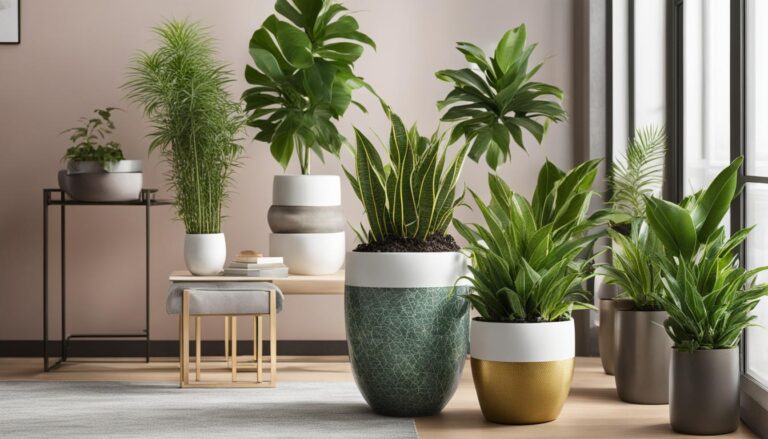

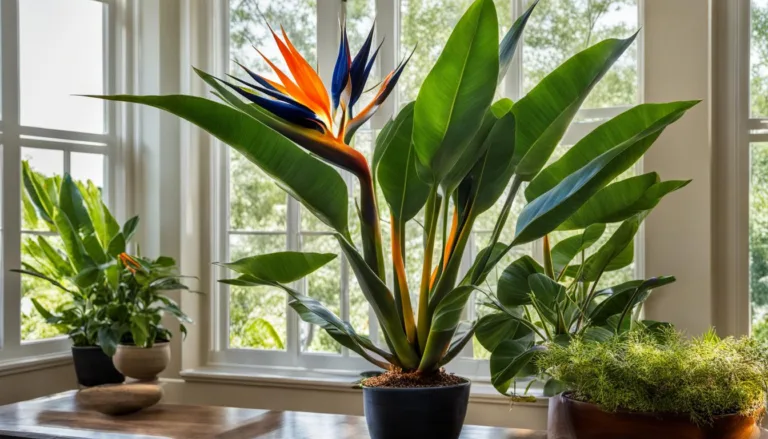
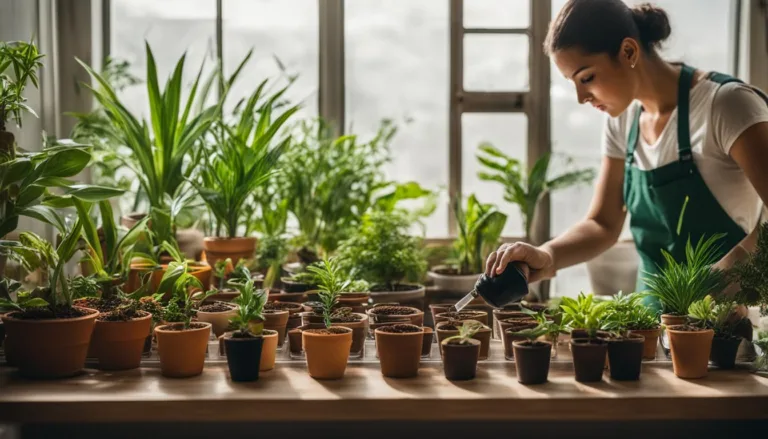
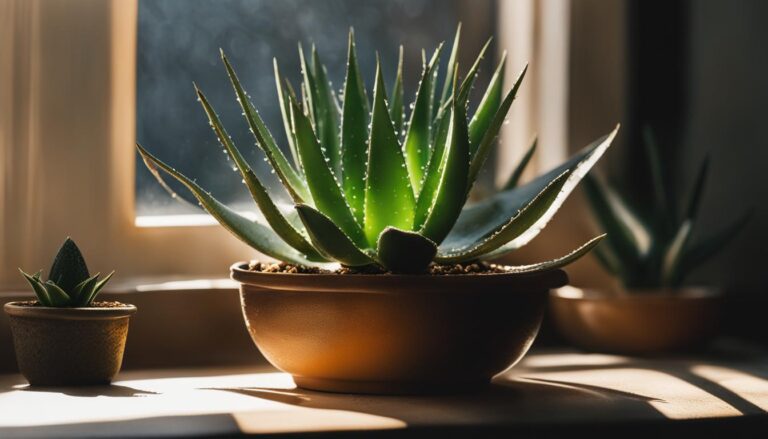
2 Comments